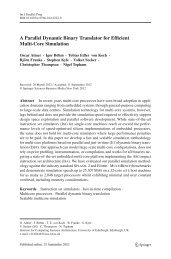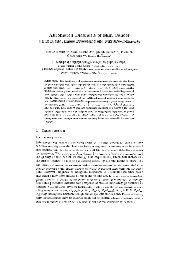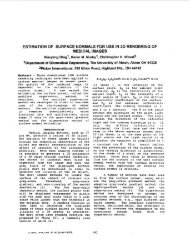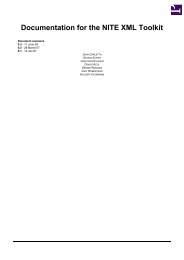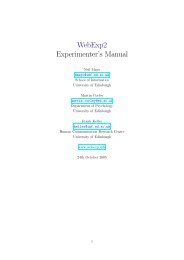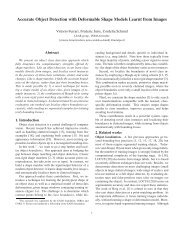Compiling for Automatically Generated Instruction Set Extensions
Compiling for Automatically Generated Instruction Set Extensions
Compiling for Automatically Generated Instruction Set Extensions
Create successful ePaper yourself
Turn your PDF publications into a flip-book with our unique Google optimized e-Paper software.
<strong>Compiling</strong> <strong>for</strong> <strong>Automatically</strong> <strong>Generated</strong><strong>Instruction</strong> <strong>Set</strong> <strong>Extensions</strong>Alastair Murraya.c.murray@ed.ac.ukBjörn Frankebfranke@inf.ed.ac.ukInstitute <strong>for</strong> Computing Systems ArchitectureSchool of In<strong>for</strong>matics, University of EdinburghIn<strong>for</strong>matics Forum, 10 Crichton Street, Edinburgh, EH8 9AB, United KingdomABSTRACTThe automatic generation of instruction set extensions (ISEs) toprovide application-specific acceleration <strong>for</strong> embedded processorshas been a productive area of research in recent years. The use ofautomatic algorithms, however, results in instructions that are radicallydifferent from those found in conventional ISAs. This hasresulted in a gap between the hardware’s capabilities and the compiler’sability to exploit them. This paper proposes an innovativehigh-level compiler pass that uses subgraph isomorphism checkingto exploit these complex instructions. Our extended code generatoralso enables the reuse of ISEs designed <strong>for</strong> one application in another,which may be a newer version of the same application or adifferent one from the same domain. Operating in a separate passpermits computationally expensive techniques to be applied that areuniquely suited <strong>for</strong> mapping complex instructions, but unsuitable<strong>for</strong> conventional instruction selection. We demonstrate that thistargeted use of an expensive algorithm effectively controls overallcompilation time. The existing, mature, compiler back-end canthen handle the remainder of the compilation. <strong>Instruction</strong>s are automaticallyproduced <strong>for</strong> 179 benchmarks, resulting in a total of1965 unique instructions. The high-level pass integrated into theopen-source GCC compiler is able to use the instructions produced<strong>for</strong> each benchmark to obtain an average speed-up of 1.26 <strong>for</strong> theENCORE extensible processor.Categories and Subject DescriptorsD.3.4 [Programming Languages]: Processors—Code generationGeneral TermsDesign, experimentation, per<strong>for</strong>manceKeywordsCode generation, instruction set extensions, subgraph isomorphism1. INTRODUCTIONSpecializing processors <strong>for</strong> a particular domain is an effective wayof increasing the per<strong>for</strong>mance achievable <strong>for</strong> a given level of powerconsumption. The most obvious examples of this are the differentprocessor families <strong>for</strong> different domain areas. Digital SignalProcessors (DSPs) are based on VLIW or static superscalar designs,with scratchpad memories and specialized instructions (e.g.a multiply-accumulate, MAC, that is common in DSP tasks). Otherprocessor families include Network Processors, or general purposeembedded processors ranging from microcontrollers, used in everythingfrom hard-disk drives to cars to washing machines, up tohigh per<strong>for</strong>mance processors used in portable media players, smartphones,netbooks, etc.While selecting the correct processor from the correct family andthen configuring it appropriately results in a processor well-matchedto a task, designing custom hardware can dramatically reducethe power required <strong>for</strong> the targeted task [12]. Taking this ideato its full extent results in Application Specific Integrated Circuits(ASICs), which are very high per<strong>for</strong>mance and low power, but taketime and ef<strong>for</strong>t to develop so they are neither low cost nor have ashort time-to-market. Additionally, once they have been deployedtheir functionality is set, new features may not be implementedand bugs cannot be fixed. An increasingly popular compromisebetween ASICs and general purpose embedded processors are ApplicationSpecific <strong>Instruction</strong>-set Processors (ASIPs). These processorstake a pre-verified baseline processor as a core and add extensioninstructions, thus standard tasks can use the baseline processorbut critical kernels can be programmed to use the extensionhardware. This strikes a balance between per<strong>for</strong>mance and timeto-market,and the pre-verified baseline avoids much of the riskinvolved in developing new hardware.Manually designed ASIPs can outper<strong>for</strong>m general purpose embeddedprocessors, use less power and are quicker and cheaper to designthan ASICs [13]. Using Automated <strong>Instruction</strong> <strong>Set</strong> Extension(AISE) to automatically design ASIPs, however, improves on thisyet again. A set of automated tools can do this by profiling theapplication to find hot-spots and analyzing the data-flow at thesespots to produce instruction definitions. These definitions can thenbe used to automatically create the hardware based on the data-flowgraphs [5]. Examples of such extensible processors are the SYNOP-SYS ARC 600 and 700 series, the TENSILICA XTENSA, the ARMOPTIMODE and the MIPS PRO series.Using AISE to design ASIPs is an effective way to design hardware[11]. The problem, however, is that the capabilities of compilerslag behind the features of the hardware. This paper, there<strong>for</strong>e,investigates how the compiler can effectively use an AISE producedprocessor.The standard methodology <strong>for</strong> using extension instructions withinprograms is <strong>for</strong> the AISE tool to note where it finds each exten-
d a t a = i n p u t ;c o e f = c o e f f i c i e n t ;sum = 0 . 0 ;f o r ( i = 0 ; i < 8 ; i ++) {# term1 = ∗ d a t a ++;# term2 = ∗ c o e f ++;sum += term1 ∗ term2 ;}∗ o u t p u t = sum ;rDVin 0rC rA rBVout 0 Vout 1d a t a = i n p u t ;c o e f = c o e f f i c i e n t ;sum = 0 . 0 ;term1 = ∗ d a t a ++;term2 = ∗ c o e f ++;f o r ( i = 1 ; i < 8 ; i ++) {sum += term1 ∗ term2 ;# term1 = ∗ d a t a ++;# term2 = ∗ c o e f ++;}sum += term1 ∗ term2 ;∗ o u t p u t = sum ;.(a) Snippet from UTDSP lmsfir 8-1 ptrs.rNrMrPrO(b) Extension instruction generated from thecode in figure (a).rRrTrQrS.(c) Snippet from UTDSP lmsfir 8-1 ptrs SWP.Figure 1: The extension instruction in figure (b) was generated from the code in figure (a). It is possible, however, to map it to boththe code in figure (a) and (c). The lines of code that it implements are marked by a #, it executes four iterations of those lines in oneinstruction as GCC unrolls both loops by a factor of four. Figure (c) is the software pipelined version of figure (a).sion, but there is no compiler support <strong>for</strong> the generated ISEs. Thisis due to the directed acyclic graph (DAG) structure and complexityof the ISEs, which typically operate on more than two operands(up to 12 in our case) and generate more than one result (up to8). Lack of compiler support is acceptable in the situation wherea single program is being accelerated, but it creates an issue if theprogram needs to be changed after the processor has been fabricated.Re-running the AISE tool may generate different instructionsrequiring an engineer to manually map the old extensions tothe new code, which is both time-consuming and error-prone [12].It would be more appropriate <strong>for</strong> the compiler to automatically per<strong>for</strong>mthe mapping <strong>for</strong> the engineer. This, however, turns out tobe a difficult task. The <strong>Instruction</strong> <strong>Set</strong> <strong>Extensions</strong> (ISEs) producedby AISE are often far too complicated <strong>for</strong> conventional tree-basedinstruction selection (indeed, the instructions are often DAGs, nottrees, see figure 1(b)), and they are often far too large <strong>for</strong> peepholebasedinstruction selection. Some <strong>for</strong>m of graph-based instructionmapping is required instead; this has been investigated previously[16, 10, 19], but <strong>for</strong> much smaller instructions than thoseproduced by AISE.1.1 Motivating ExampleFigure 1 shows short snippets of codes from the UTDSP lmsfir 8-1ptrs benchmark (figure 1(a)) and a version of the program whichhas been software pipelined (figure 1(c)). Figure 1(b) shows an extensioninstruction that was generated <strong>for</strong> the code in figure 1(a). Itrepresents two sequential sequences of pointer incrementation (thetwo sequences can be calculated in parallel). The long sequencesare possible because the GCC optimizer unrolled the loops by a factorof four. In a conventional AISE setup it would not be possible tore-use the extension instruction in a different piece of code because(a) rerunning the AISE tool on different code would result in differentinstructions being generated, or (b) the graph-based <strong>for</strong>m ofthe extension instructions (see figure 1(b)) can not be processed byconventional tree-based instruction selectors. The technique presentedin this paper was able to re-use the extension instruction,despite the different code-shape. This is because the subgraph stillexists within the different shape so graph-subgraph isomorphism isable to identify where the instruction can be used. The lines markedwith a # represent where the extension instruction was able to beused, in both in original file it was generated <strong>for</strong>, and the softwarepipelined version.Most existing techniques <strong>for</strong> complex instruction mapping are designed<strong>for</strong> finding good, i.e. near optimal, solutions when usingsmall graph-shaped instructions. They do not, however, generallyscale well to very large instructions – most papers per<strong>for</strong>m evaluationsusing instructions with only two operations in them. E.g. theapproach taken in [9] finds every possible overlapping use of eachinstruction be<strong>for</strong>e selecting which ones it wants to use. This onlyworks <strong>for</strong> small instructions, e.g. to map a single instruction (oftwo, three or eight nodes) in a single basic block of one hundrednodes has a worst-case complexity of ( 30) (2 = 435, or 30 )3 = 4,060but ( 30) 8 = 5,852,926. Although in reality it is unlikely that theworst case will occur, large instructions are still clearly not practicalwith this class of technique. Figure 2 shows the distribution ofthe number of nodes in instructions and basic blocks across all 179benchmarks used <strong>for</strong> evaluation.1.2 ContributionsThis paper makes following contributions:1. We develop a method <strong>for</strong> mapping arbitrary graph-shaped instructions(both disjoint and not) to arbitrary programs. Thenovel aspect of the mapper is that it per<strong>for</strong>ms instructionmapping in the middle-end instead of the back-end. This allowsit to focus only on extension instructions, that the backendcannot exploit. The mature and tuned back-end per<strong>for</strong>mseffective instruction selection <strong>for</strong> the code that is not mappedto extension instructions.2. We per<strong>for</strong>m an extensive evaluation using 179 benchmarksfrom seven benchmark suites obtained from five sources. Resultsare generated using a hardware-verified cycle-accuratesimulator. Additionally, the instruction mapper is evaluatedusing extension instructions generated <strong>for</strong> programs that aresimilar (but not identical to) the programs that they are mappedto, demonstrating the compiler’s capability to re-use ISEsin programs other than the one they have been generated <strong>for</strong>.
70010000600Number of <strong>Instruction</strong>s500400300200Number of Basic Blocks10001001010000 5 10 15 20 25 30 35 40 45 50Number of Nodes in <strong>Instruction</strong>(a) Distribution of size of extension instructions.10 100 200 300 400 500 600 700Number of Nodes in Basic Block(b) Distribution of size of basic blocks (logarithmic scale).Figure 2: The distribution of the number of nodes in the graphs used <strong>for</strong> graph-subgraph isomorphism.1.3 OverviewThe remainder of this paper is structured as follows. In section 2we introduce extensible processors and the existing approaches toautomated instruction set extension. This is followed in section 3by a presentation of our novel code generation methodology <strong>for</strong>AISE generated instruction patterns. We demonstrate the effectivenessof our approach through experimental evaluation in section 4be<strong>for</strong>e we discuss related work in section 5. Finally, in section 6 wesummarize our results, conclude and provide an outlook to futurework.2. BACKGROUNDThis section provides a short overview of the technologies relevantto the work of this paper.2.1 Extensible ProcessorsExtensible processors are based on the premise that processor per<strong>for</strong>mance,die area, and power consumption can be improved ifthe architecture of the processor is extended to include some featuresthat are application-specific. This approach requires an abilityto extend the architecture and its implementation, as well as thecompiler and associated binary utilities, to support the applicationspecificextensions.Architecture extensions begin with the capability to add custominstructions to a baseline instruction set. In their simplest <strong>for</strong>mthese may be predefined packs of add-on instructions, such as theARM DSP-enhanced extensions included in the ARM9E [3], thevarious flavors of MIPS Application Specific <strong>Extensions</strong> [17], orSYNOPSYS’ floating-point extensions to the ARCOMPACT instructionset [2].These are domain-specific extensions, they can be used across manyrelated tasks. Application-specific instruction set extensions arenot predefined by the processor vendor but are instead identifiedby the system integrator through analysis of the application. Toallow such instructions to be incorporated into a pre-existing processorpipeline, there must be a well-defined extension interface.From a high-level architecture perspective this interface will allowthe extension to operate as a “black-box” functional unit atthe execute (Ex) stage of a standard RISC pipeline. This is an oversimplificationthough, standard RISC instructions are two-input andone-output. Effective extension instructions require this constraintto be relaxed as extensions exploit the parallelism available in largeinstructions. This, there<strong>for</strong>e, generally requires an extended or additionalregister file, hence the need <strong>for</strong> an extension interface.Practical extensible processors <strong>for</strong> the embedded computing market,such as those from SYNOPSYS and TENSILICA, normally havesingle-issue in-order pipelines of 5-7 stages. This permits operatingfrequencies in the range 400-700MHz at the 90nm technologynode. Extension instructions may be constrained to fit within asingle clock cycle, or may be pipelined to operate across multiplecycles.The representation of instruction set extensions varies from onevendor to another, but essentially describes the encoding and semanticsof each extension instruction in ways that can be understoodby both a processor generator tool and all of the softwaretools (e.g. compilers, assemblers and simulators). There followsa process of translating the abstract representation of the extensioninstructions to structural <strong>for</strong>m using a Hardware Description Language(HDL) such as VERILOG or VHDL. This is then incorporatedinto the overall HDL definition of the processor, that is then synthesizedto the target silicon technology or perhaps to an FPGA.2.2 Automated <strong>Instruction</strong> <strong>Set</strong> ExtensionMany algorithms <strong>for</strong> AISE have been described in the literature,[11] provides a comprehensive survey of the topic. The algorithmused <strong>for</strong> the generation of ISEs in following sections of this paper,however, is ISEGEN [5].The most basic constraints on extension instructions are:1. The template is convex (i.e. there is no dataflow path betweentwo operations in the template that includes an operation thatis not in the template), so that it may be scheduled.2. Input and output port constraints are met (i.e. the number ofregister input and output ports are sufficient), so that it may
GCCMAPISESource CodeFront-EndMiddle-EndBuildGraphicalIRModifyGIMPLEBack-EndBinaryExtension<strong>Instruction</strong>sGraphMatchingGENERIC GIMPLE DFG RTLFigure 3: The structure of passes within GCC and MAPISE.be implemented.Every node in the basic block implements some simple operation,in the model there are hardware and software costs <strong>for</strong> each operation.The hardware cost is the fraction of a cycle (maybe greaterthan one cycle) that it takes to per<strong>for</strong>m the operation. The softwarecost is the number of cycles the standard instruction that per<strong>for</strong>msthis operation takes to complete. Essentially, the AISE algorithmgenerates data-flow graph templates by iteratively attempting togrow extension instructions. The benefit of adding each node tothe current “cut” (instruction) is considered by looking <strong>for</strong> instructionswhich will replace many software cycles with a few hardwarecycles. Following the generation of templates from basic blocks,the templates are checked <strong>for</strong> isomorphism with one another so asduplicates may be eliminated, then ranked using their per-executiongain.3. METHODOLOGYThe tool that implements the techniques described in the paper,MAPISE, works as a series of sub-passes, as shown in figure 3.First a graphical intermediate representation (IR) <strong>for</strong>m is built, thenextension instructions are mapped to that. Finally the original GIM-PLE is modified.3.1 Integration into GCCMAPISE is implemented in GCC 4.2. GCC operates in four mainstages: a front-end, a high-level middle-end, a low-level middleendand a back-end. The pass presented in this paper, MAPISE,runs at the end of the high-level middle-end while the IR is still inSSA <strong>for</strong>m.GCC uses several IRs. The front-ends translate the input sourcecode into GENERIC, a high-level IR. This is then lowered intoGIMPLE, a medium-level IR used by the high-level middle-end.GIMPLE can be used in both an SSA and a non-SSA <strong>for</strong>m, but mosthigh-level optimization passes operate on the SSA <strong>for</strong>m, includingMAPISE. The GIMPLE <strong>for</strong>m is then lowered again into a low-levelIR: RTL (register transfer language). Low-level optimization andtarget specific passes operate on RTL. Finally the back-end per<strong>for</strong>msinstruction selection on the RTL <strong>for</strong>m ensuring all operationshave a one-to-one mapping with assembly. These operations arealso annotated with register and scheduling constraints that are usedby the register allocator and the scheduler respectively be<strong>for</strong>e theRTL is finally converted into assembly.The instruction mapper presented in this paper, MAPISE, exploitsGCC’s support <strong>for</strong> extended inline assembly. This is required towork around a lack of support <strong>for</strong> specific features that an extensioninstruction mapping pass requires. The most unusual requirementis the need to support an arbitrary number of extension unitswith a single compiler binary. If any changes are made to a GCCback-end then GCC must be recompiled. A processor designer orapplication developer may be evaluating several hundred extensionconfigurations as a design space exploration exercise. Even if theprocess is automated this would likely still hinder productivity. Theimplementation described in this paper avoids this by taking a descriptionof the extension unit as part of its input. This way, therequirement of deploying a single compiler install can be satisfied,while still supporting an arbitrary number of extension units.This requirement can be satisfied by inserting ASM statement operationsinto the IR. These are usually generated by the front-endwhen a program contains inline assembly. No other passes in GCCinsert ASM operands into the IR but the alternative approacheswould require GCC to be recompiled with each change. It is worthnoting that GCC’s extended ASM operations require a precise definitionof the operation’s dependencies and outputs, this allows theoptimization passes to continue to be effective even when ASMstatements are present.If MAPISE mapped any extension instructions onto a function,then once the mapping pass is complete the pass manager is configuredto re-run loop-invariant code-motion as the mapping passintroduces various temporaries that may benefit from being hoisted.3.2 Construction of Graphical IRAs MAPISE is based on graph-subgraph isomorphism checking, itmust operate on a graphical intermediate representation (IR). Forthis purpose an IR called DFG (Data-Flow Graph) was specified bythe author of ISEGEN. As this IR was not going to be used <strong>for</strong>compilation it did not need to be complete. For a given programthe DFG representation is a list of basic blocks with no controlflowin<strong>for</strong>mation describing how they link together. This is ideal<strong>for</strong> the purposes of AISE tools since they only look <strong>for</strong> dataflowgraphs within basic blocks, control flow in<strong>for</strong>mation is extraneous.Each basic block is a list of nodes and edges and each possiblenode-type has a one-to-one mapping to some type of GIMPLE node.The converse is not true, however, GIMPLE has many types ofnodes not supported by DFG.
(a) A disjoint extension instruction.(b) An extension instruction where the value saved in rNis also used internally.Figure 4: Example extension instructions automatically generated <strong>for</strong> an AES benchmark.For the purposes of AISE, a pass was created in GCC that iteratesover the GIMPLE representation of a program and produces a DFGrepresentation. The representation is then serialized into XML andthe resultant in<strong>for</strong>mation transferred to the AISE tools.MAPISE also needs to operate in DFG because the extension instructiondefinition is provided to it in XML DFG <strong>for</strong>mat. MAPISEthere<strong>for</strong>e processes GIMPLE to create a list of DFG basic blocks andparses the provided XML to create a list of DFG instructions. Themanner in which these two tasks occur is completely mechanicaland there<strong>for</strong>e not discussed here. At this stage, however, MAPISEhas to do some additional post-processing of the DFG.Firstly, cast nodes need to be removed as the XML DFG providedwill have already had this done on the basis that the hardware implementationof the extension instructions operate on 32-bit arithmetic.Secondly, pointer aliasing in<strong>for</strong>mation is used to add virtualdependencies between DFG nodes if GCC’s virtual use and definesstate that two nodes are dependent. This means that if operationX writes to memory, and operation Y reads from what may be thesame memory location then Y has a virtual dependence on X. Thismeans that Y must occur after X.Finally, the VFLIB implementation of the VF2 algorithm [8] thatis used to per<strong>for</strong>m graph-subgraph isomorphism checking requiresgraphs to be in its own <strong>for</strong>mat, so <strong>for</strong> every basic block and everyextension instruction definition an additional representation is built.3.3 Matching SubgraphsTo find where extension instructions may be mapped, a greedysearch strategy is used. The extension instructions are sorted bytheir expected gains. Then, <strong>for</strong> each basic block every instructionis iterated over. The basic blocks are simply iterated over from startto end, the instructions, however, are ordered according to their expectedbenefit – the best instructions are considered first. Each basicblock and extension instruction pair is passed to VFLIB and ifthe instruction is a sub-graph of the basic block then a match isrecorded. Every DFG node that was just mapped to an extensioninstruction gets marked as such to avoid a node being mapped tomultiple instructions. The same pattern that was just mapped is retried,in case the same pattern may be reused. This process repeatsuntil every extension instruction has been checked.When VFLIB finds a place to map an extension instruction, it isnecessary to check the mapping is viable prior to its application.As a consequence of MAPISE supporting disjoint extension instructionsit is possible <strong>for</strong> VFLIB to find mappings which violateconvexity constraints. Convexity violations can occur whenone of two (or more) disjoint parts of an instruction become indirectlydependent on the other part of the instruction. The resultis that the extension instruction must be scheduled both be<strong>for</strong>eand after the intermediary node(s): a clear impossibility. This canonly happen with extension instructions which contain disjoint subgraphs,such as in the instruction in figure 4(a). It contains threeunconnected sub-graphs and according to the graph-subgraph isomorphismdefinition (and thus also the VF2 algorithm) each subgraphmay be mapped to anywhere in the graph, irrespective ofindirect dependencies which means that convexity violations arepossible. If convexity constraints are violated then the key offendingnode is marked as unusable and the extension instruction istried again. This is allowed to occur a maximum of 10,000 timesper basic block/extension instruction pair. Convexity violations arequite common: across the set of 179 benchmarks it was observedthat mapping was re-run 279,851 times due to convexity violationsand the 10,000 iteration limit was reached 97 times.3.4 Determining if Two Nodes are EquivalentA function is provided to VFLIB that when given one node fromthe graph (basic block) and one node from the subgraph (extensioninstruction definition) it determines whether or not they areequivalent. As this function is per<strong>for</strong>mance critical (it accounts<strong>for</strong> 46% of MAPISE’S run-time, see table 1) it attempts to establishnon-equivalence as quickly as possible. This does not changethe complexity of the problem as, in algorithmic terms, the nodeequivalence function can be thought of as having a constant executiontime. In practice, however, reducing the average duration ofthis constant-time significantly reduces the run-time of MAPISE asthis function is called so frequently.Various other properties must be satisfied <strong>for</strong> two nodes to be consideredequivalent:• If the nodes do not per<strong>for</strong>m the same operation, have differentdata types or the basic block node takes a 64-bit value asinput, then the nodes are not equivalent. If these nodes areconstants then they must have the same value, or they are notequivalent.
Time (seconds)Time (seconds)Speed-up2.01.81.61.41.21.00.810000crypto teadspstone fir fixedeembc1 office dither01eembc1 automotive aifftr0110001000.10.01100101010.10.010.0011crypto teadspstone fir fixedeembc2 consumer mpeg2deceembc1 automotive aifftr01crypto teadspstone fir fixedUTDSP edge detect arrayseembc2 consumer mpeg2enceembc1 office dither01eembc2 consumer mpeg2deceembc1 office dither01eembc1 automotive aifftr01eembc2 consumer mpeg2enceembc2 consumer mpeg2decUTDSP fft 1024 ptrsUTDSP edge detect arrayseembc2 consumer mpeg2encCryptography (10)DSPstone (29)EEMBC-1 Consumer (5)EEMBC-1 Automotive (16)EEMBC-1 Office (4)EEMBC-1 Networking (3)Speed-up from extension instructionsEEMBC-1 Telecom (5)(a) Speed-up due to using extension instructions.UTDSP fft 1024 ptrsUTDSP fft 1024 ptrsUTDSP edge detect arraysCryptography (10)DSPstone (29)EEMBC-1 Consumer (5)EEMBC-1 Automotive (16)EEMBC-1 Office (4)EEMBC-1 Networking (3)(b) The run-time of various tools.Cryptography (10)DSPstone (29)EEMBC-1 Consumer (5)EEMBC-1 Automotive (16)EEMBC-1 Networking (3)EEMBC-2 Consumer (9)EEMBC-1 Telecom (5)EEMBC Coremark (1)EEMBC-2 Networking (7)EEMBC-2 Consumer (9)EEMBC Coremark (1)EEMBC-2 Networking (7)SNURT (15)SNURT (15)UTDSP (75)AVERAGE (179)Time taken to generate extension instructionsTime taken to compile without extensionsTime taken to compile with extensionsEEMBC-1 Office (4)EEMBC-1 Telecom (5)EEMBC-2 Consumer (9)EEMBC Coremark (1)EEMBC-2 Networking (7)SNURT (15)UTDSP (75)AVERAGE (179)Time taken to compile without extensionsTime taken to match a single extension instructionUTDSP (75)AVERAGE (179)(c) Time to compile a benchmark without extensions compared to the average time to map one extension instruction to entire benchmark.Figure 6: The results of using extension instructions. A few representative results are shown on the left of the break, on the right areaggregate results <strong>for</strong> each benchmark suite. The number in the brackets is the number of benchmarks in that suite.
Task Time (s) Time (%) Sub-Task Time (s) Time (%)Build IRs 27.49 0.9% Parse XML <strong>Instruction</strong>s 9.33 0.3%Build DFG 5.09 0.2%Clean BB graphs 7.97 0.3%Build VF2 graphs 5.1 0.2%Mapping 2,904.3 96.1% VF2 Algorithm 1,482.6 49.1%Node Comparison 1,384.9 45.8%Viability Checking 33.07 1.1%Register Allocation 6.92 0.2%GIMPLE Modification 83.43 2.8% Scheduling 82.95 2.7%Table 1: The total time spent in each sub-pass of MAPISE. The timings are from the summation of all 179 benchmarks.task dominates, the tool spends 49.1% of its time in the internalsof the VF2 algorithm. Additionally that algorithm makes use ofthe node comparison functions, which account <strong>for</strong> an additional45.8% of the run-time. Figure 6(c) normalizes MAPISE’S runtime<strong>for</strong> a single extension instruction (the MAPISE run-time isdivided by the number of extension instructions processed). Thisdemonstrates that on a per-extension-instruction basis small benchmarks(e.g. DSPStone) can take longer <strong>for</strong> MAPISE to process thanlarge benchmarks (e.g. EEMBC-1 Consumer). For small kernelbasedbenchmarks GCC will tend to unroll inner loops, creatinglarge basic-blocks which the small number of extension instructionswill map to. For large benchmarks, however, most extensioninstructions will be found to trivially not-map to most of the basicblocks as they are only mappable to a small number of sites.So the complexity of the graph-subgraph isomorphism problem <strong>for</strong>each basic-block and extension instruction pair strongly influencesMAPISE’S run-time.4.3 Re-use of AISEsThe results of re-using extension instructions on benchmarks thatare similar (but not identical) to the ones that they were generated<strong>for</strong> are shown in figure 7. It can be seen that small changes to thecode-shape only result in a small reduction in per<strong>for</strong>mance, from anaverage speed-up of 1.16 to 1.13. Though in a few outlying casesthe ability to use the extension instructions may be lost completely,e.g. UTDSP latrnm 32-64 arrays. This demonstrates that MAPISEis able to effectively use extension instructions even when the originalprogram is modified.5. RELATED WORKAn early piece of work in the area of complex instruction selectionwas undertaken by Leupers and Marwedel [15]. They targetedinstructions that may be represented as disjoint data-flowtrees, i.e. their operations occur in parallel. For example: instead oftargeting deep multiply accumulate instructions, they target widemultiply accumulates where the accumulation occurs via an architecturallyvisible temporary register and the result of the previousmultiply is accumulated. The problem is encoded as the set of registertransfer paths possible on the processor, and the set of transfersthat each instruction implements. Standard optimal tree coveringis per<strong>for</strong>med on these register transfers and then an integerlinear program is used to find instructions that may cover multipleregister transfers. The type of hardware that this technique targetsis less common now and small parallel instructions have mostlybeen replaced with short tree equivalents, reducing the usefulnessof the technique since it was developed. The work was later revisitedthough [14] to target a parallel <strong>for</strong>m of instructions: sub-wordSIMD. Sub-word SIMD tries to pack small operations into standardarithmetic instructions, e.g. packing four 8-bit additions into a32-bit addition. A standard optimal tree covering technique is extendedso that instead of finding a single optimal covering it findsall optimal coverings. An integer linear program is then used tofind a set of SIMD instructions that is capable of working withinthe register constraints that sub-word SIMD introduces. This is aninteresting extension but is not equivalent to the instruction mappingrequirements of this paper: sub-word SIMD instructions arefar simpler than AISE generated extension instructions.Arnold and Corporaal [4] extended the standard optimal dynamictree programming algorithm to be able to handle instructions withmultiple outputs. In principle, the cost function of the standard dynamicalgorithm is modified so that when an output of the multipleoutputinstruction is used as an input to a node the cost is dividedby the number of outputs. This breaks the dynamic tree coveringalgorithm’s ability to find an optimal covering but the effects of thatare not evaluated in the paper.Scharwaechter et al. [18] continue the development of complex instructionmappers by extending the idea of a code-generator generatorto be able to handle parallel instructions. The extended generatorrepresents basic blocks and instructions as directed acyclicgraphs (DAGs). Several heuristics are used to help reduce a worstcaseexponential run-time down to an average-case linear run-time.The set of instructions evaluated were the fusion of only two unconnectedsimple operations. These are far smaller than the extensioninstructions considered in this paper and could potentiallymean this technique is inappropriate <strong>for</strong> instructions generated <strong>for</strong>ASIPs.Ebner et al. [9] produced a technique <strong>for</strong> matching graph-based instructionsbased on a SSA representation. The algorithm finds everypossible (overlapping) place to use each instruction. This has aworst-case complexity of O( ( nk)) where n is the number of nodes ina basic block and k in the number of nodes in an instruction, howeverin practice the complexity is much lower. Each assignmentthen becomes a variable in a partitioned binary quadratic problem,and is either mapped to an integer linear program <strong>for</strong> solving optimallyor is solved heuristically. The technique was evaluated onthe ARM ISA, but again this does not contain any particularly complexinstructions. There<strong>for</strong>e this technique is not shown to workwith complex extension instructions. The worst-case complexity ofO( ( nk)) makes it very likely the technique will not scale <strong>for</strong> large instructions,as when the number of nodes in an instruction (k) growsthe complexity explodes.Finally, Clark et al. [7] describe a promising technique that uses
Speed-up2.01.81.61.41.21.00.8UTDSP adpcm arraysUTDSP compress arraysUTDSP fft 1024 arraysUTDSP edge detect arraysUTDSP fir 32 1 arraysUTDSP fir 256 64 arraysUTDSP iir 1 1 arraysUTDSP histogram arraysUTDSP iir 4 64 arraysUTDSP latnrm 8 1 arraysUTDSP latnrm 32 64 arraysUTDSP lmsfir 8 1 arraysUTDSP lmsfir 32 64 arraysDirectly using extension instructionsRe-targeting extension instructionsUTDSP lpc arraysUTDSP mult 4 4 arraysUTDSP mult 10 10 arraysUTDSP spectral arraysAVERAGEFigure 7: The results of generating extension instructions <strong>for</strong> UTDSP benchmarks using pointer arithmetic but then using them withthe array version of each benchmark. The left-hand bar <strong>for</strong> each benchmark shows the speed-up achieved by using instructionsgenerated <strong>for</strong> each arrays benchmark specifically, the right-hand bars show the speed-up achieved by re-targeting the ptrs extensioninstructions.“Full Enumeration – Unate Covering” to allow effective considerationof multiple extension instructions at once. The run-timerequirements are kept under control by heuristically pruning thesearch space when it gets too large. This is an alternative solution todealing with the problem of using multiple extension instructions,other than the greedy approach presented in this paper. Unlike thispaper, however, it only considers instructions with at most fourinputsand two-outputs (opposed to the twelve-inputs and eightoutputsused in this paper). It also only considers singly connectedgraphs – the work in this paper allows instructions to be disjointgraphs. It is not clear whether the algorithm’s low run times wouldbe maintainable if these features were added.6. SUMMARY AND CONCLUSIONSTechniques <strong>for</strong> automated instruction set extension, which producelarge, complex extension instructions, have been shown to generatehighly specialized and energy-efficient ASIPs. Without adequatecompiler support, however, making use of these instructions is adifficult process. In this paper we have demonstrated that by focusingsolely on complex extension instructions a high-level instructionselection pass can use computationally expensive algorithmswhile maintaining an acceptable run-time. The conventional compilerback-end can then generate scalar code <strong>for</strong> the remainder ofthe compilation. We have implemented our novel instruction selectionpass in GCC and evaluated it against 179 benchmarks anda total of 1965 automatically generated instructions. Our new codegenerator is able efficiently exploit complex, automatically generatedinstruction set extensions and achieves an average speed-up of1.26 <strong>for</strong> the ENCORE extensible processor.Our future work will focus on the integration of the extended compilerinto a framework <strong>for</strong> AISE design space exploration.References[1] O. Almer, R. Bennett, I. Böhm, A. Murray, X. Qu, M. Zuluaga,B. Franke, and N. Topham. An end-to-end designflow <strong>for</strong> automated instruction set extension and complex instructionselection based on GCC. In Proceedings of theFirst International Workshop on GCC Research Opportunities(GROW ’09), pages 49–60, January 2009.[2] ARC International. ARC FPX white paper, 2007. URL http://www.arc.com/configurablecores/fpx.[3] ARM Ltd. ARM DSP-enhanced extensions, 2001. URLhttp://www.arm.com/pdfs/ARM-DSP.pdf.[4] M. Arnold and H. Corporaal. Designing domain-specific processors.In Proceedings of the 9th International Symposiumon Hardware/Software Codesign (CODES ’01), pages 61–66,April 2001.[5] P. Biswas, S. Banerjee, N. D. Dutt, L. Pozzi, and P. Ienne.ISEGEN: an iterative improvement-based ISE generationtechnique <strong>for</strong> fast customization of processors. IEEE Trans.Very Large Scale Integr. Syst., 14:754–762, July 2006.[6] I. Böhm, B. Franke, and N. Topham. Cycle-accurate per<strong>for</strong>mancemodelling in an ultra-fast just-in-time dynamic binarytranslation instruction set simulator. Transactions onHigh-Per<strong>for</strong>mance Embedded Architectures and Compilers(HiPEAC’11), 5(4), 2011.[7] N. Clark, A. Hormati, S. Mahlke, and S. Yehia. Scalablesubgraph mapping <strong>for</strong> acyclic computation accelerators. InProceedings of the ACM 2006 International Conference onCompilers, Architecture and Synthesis <strong>for</strong> Embedded Systems(CASES ’06), pages 147–157, October 2006.[8] L. P. Cordella, P. Foggia, C. Sansone, and M. Vento. Graphmatching: A (sub)graph isomorphism algorithm <strong>for</strong> matchinglarge graphs. IEEE Transactions on Pattern Analysis andMachine Intelligence, 26(10):1367–1372, 2004.[9] D. Ebner, F. Brandner, B. Scholz, A. Krall, P. Wiedermann,and A. Kadlec. Generalized instruction selection using SSAgraphs.In Proceedings of the ACM SIGPLAN/SIGBED Con-
ference on Languages, Compilers, and Tools <strong>for</strong> EmbeddedSystems (LCTES ’08), pages 31–40, March 2008.[10] M. A. Ertl. Optimal code selection in DAGs. In Proceedingsof the 26th ACM SIGPLAN-SIGACT symposium on Principlesof programming languages, POPL ’99, pages 242–249, NewYork, NY, USA, 1999. ACM.[11] C. Galuzzi and K. Bertels. The instruction-set extension problem:A survey. In Proceedings of the 4th international workshopon Reconfigurable Computing: Architectures, Tools andApplications, ARC ’08, pages 209–220, Berlin, Heidelberg,2008. Springer-Verlag.[12] P. Ienne and R. Leupers. Customizable Embedded Processors.Elsevier Inc., 2007.[13] K. Keutzer, S. Malik, and A. R. Newton. From ASIC to ASIP:The next design discontinuity. In Proceedings of the 2002IEEE International Conference on Computer Design: VLSIin Computers and Processors (ICCD’02), ICCD ’02, pages84–, Washington, DC, USA, 2002. IEEE Computer Society.[14] R. Leupers and S. Bash<strong>for</strong>d. Graph-based code selection techniques<strong>for</strong> embedded processors. ACM Transactions on DesignAutomation of Electronic Systems, 5(4):794–814, October2000.[15] R. Leupers and P. Marwedel. <strong>Instruction</strong> selection <strong>for</strong> embeddedDSPs with complex instructions. In Proceedings of theConference on European Design Automation (EURO-DAC’96), pages 200–205, 1996.[16] C. Liem, T. C. May, and P. G. Paulin. <strong>Instruction</strong>-setmatching and selection <strong>for</strong> DSP and ASIP code generation.In R. Werner, editor, EDAC-ETC-EUROASIC, pages 31–37.IEEE Computer Society, 1994.[17] MIPS Technologies. MIPS32(R) architecture <strong>for</strong> programmers,2007. URL http://www.mips.com/.[18] H. Scharwaechter, R. Leupers, G. Ascheid, H. Meyr, J. M.Youn, and Y. Paek. A code-generator generator <strong>for</strong> multioutputinstructions. In Proceedings of the International Conferenceon Hardware/Software Codesign and System Synthesis(CODES+ISSS ’07), pages 131–136, October 2007.[19] J. M. Youn, J. Lee, Y. Paek, J. Lee, H. Scharwaechter, andR. Leupers. Fast graph-based instruction selection <strong>for</strong> multioutputinstructions. Softw. Pract. Exper., 41:717–736, May2011.



